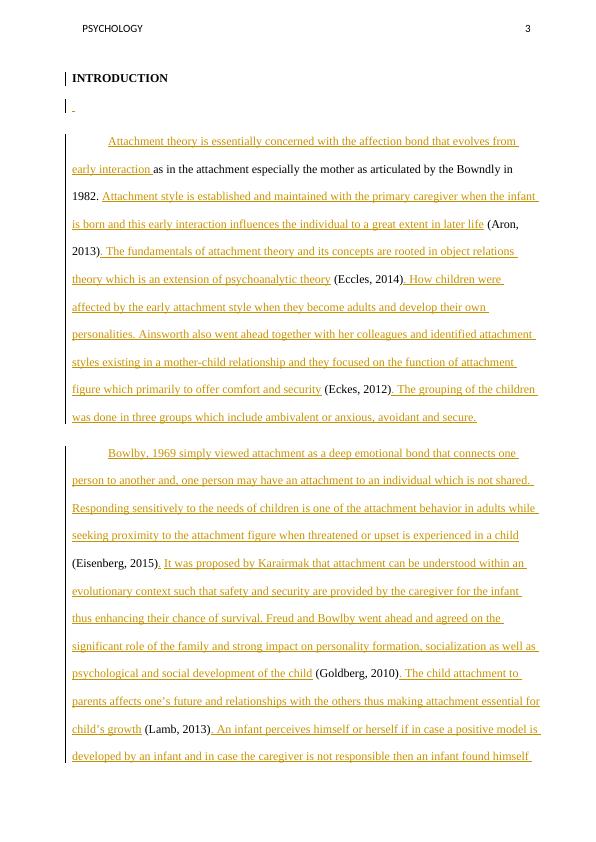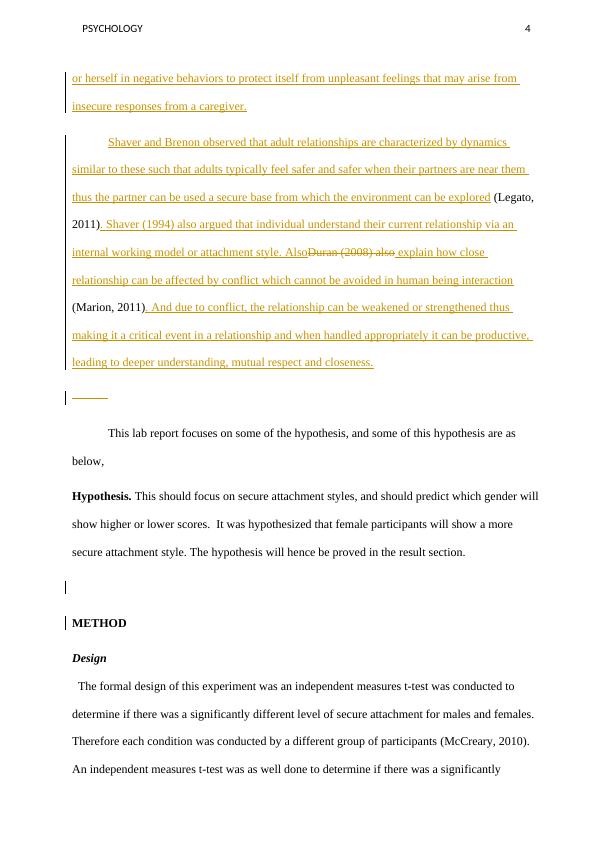Attachment Theory and Gender Differences in Secure Attachment Style
Added on 2023-06-10
20 Pages3103 Words189 Views
Running head: PSYCHOLOGY 0
PSYCHOLOGY
Name of Student
Institution Affiliation
PSYCHOLOGY
Name of Student
Institution Affiliation

PSYCHOLOGY 2
ABSTRACT
This lab report illustrates the gender which will show a higher or lower scores on the secure
attachment style as per the attachment theories and the hypothesis. The essentials of attachment
theory and its concepts are rooted in object relations theory which is an extension of
psychoanalytic theory. There are theories which are highlighted in the attachments. These
theories were then proved in the lab experiment and the results were recorded in the results
section as shown below.
ABSTRACT
This lab report illustrates the gender which will show a higher or lower scores on the secure
attachment style as per the attachment theories and the hypothesis. The essentials of attachment
theory and its concepts are rooted in object relations theory which is an extension of
psychoanalytic theory. There are theories which are highlighted in the attachments. These
theories were then proved in the lab experiment and the results were recorded in the results
section as shown below.

PSYCHOLOGY 3
INTRODUCTION
Attachment theory is essentially concerned with the affection bond that evolves from
early interaction as in the attachment especially the mother as articulated by the Bowndly in
1982. Attachment style is established and maintained with the primary caregiver when the infant
is born and this early interaction influences the individual to a great extent in later life (Aron,
2013). The fundamentals of attachment theory and its concepts are rooted in object relations
theory which is an extension of psychoanalytic theory (Eccles, 2014). How children were
affected by the early attachment style when they become adults and develop their own
personalities. Ainsworth also went ahead together with her colleagues and identified attachment
styles existing in a mother-child relationship and they focused on the function of attachment
figure which primarily to offer comfort and security (Eckes, 2012). The grouping of the children
was done in three groups which include ambivalent or anxious, avoidant and secure.
Bowlby, 1969 simply viewed attachment as a deep emotional bond that connects one
person to another and, one person may have an attachment to an individual which is not shared.
Responding sensitively to the needs of children is one of the attachment behavior in adults while
seeking proximity to the attachment figure when threatened or upset is experienced in a child
(Eisenberg, 2015). It was proposed by Karairmak that attachment can be understood within an
evolutionary context such that safety and security are provided by the caregiver for the infant
thus enhancing their chance of survival. Freud and Bowlby went ahead and agreed on the
significant role of the family and strong impact on personality formation, socialization as well as
psychological and social development of the child (Goldberg, 2010). The child attachment to
parents affects one’s future and relationships with the others thus making attachment essential for
child’s growth (Lamb, 2013). An infant perceives himself or herself if in case a positive model is
developed by an infant and in case the caregiver is not responsible then an infant found himself
INTRODUCTION
Attachment theory is essentially concerned with the affection bond that evolves from
early interaction as in the attachment especially the mother as articulated by the Bowndly in
1982. Attachment style is established and maintained with the primary caregiver when the infant
is born and this early interaction influences the individual to a great extent in later life (Aron,
2013). The fundamentals of attachment theory and its concepts are rooted in object relations
theory which is an extension of psychoanalytic theory (Eccles, 2014). How children were
affected by the early attachment style when they become adults and develop their own
personalities. Ainsworth also went ahead together with her colleagues and identified attachment
styles existing in a mother-child relationship and they focused on the function of attachment
figure which primarily to offer comfort and security (Eckes, 2012). The grouping of the children
was done in three groups which include ambivalent or anxious, avoidant and secure.
Bowlby, 1969 simply viewed attachment as a deep emotional bond that connects one
person to another and, one person may have an attachment to an individual which is not shared.
Responding sensitively to the needs of children is one of the attachment behavior in adults while
seeking proximity to the attachment figure when threatened or upset is experienced in a child
(Eisenberg, 2015). It was proposed by Karairmak that attachment can be understood within an
evolutionary context such that safety and security are provided by the caregiver for the infant
thus enhancing their chance of survival. Freud and Bowlby went ahead and agreed on the
significant role of the family and strong impact on personality formation, socialization as well as
psychological and social development of the child (Goldberg, 2010). The child attachment to
parents affects one’s future and relationships with the others thus making attachment essential for
child’s growth (Lamb, 2013). An infant perceives himself or herself if in case a positive model is
developed by an infant and in case the caregiver is not responsible then an infant found himself

PSYCHOLOGY 4
or herself in negative behaviors to protect itself from unpleasant feelings that may arise from
insecure responses from a caregiver.
Shaver and Brenon observed that adult relationships are characterized by dynamics
similar to these such that adults typically feel safer and safer when their partners are near them
thus the partner can be used a secure base from which the environment can be explored (Legato,
2011). Shaver (1994) also argued that individual understand their current relationship via an
internal working model or attachment style. AlsoDuran (2008) also explain how close
relationship can be affected by conflict which cannot be avoided in human being interaction
(Marion, 2011). And due to conflict, the relationship can be weakened or strengthened thus
making it a critical event in a relationship and when handled appropriately it can be productive,
leading to deeper understanding, mutual respect and closeness.
This lab report focuses on some of the hypothesis, and some of this hypothesis are as
below,
Hypothesis. This should focus on secure attachment styles, and should predict which gender will
show higher or lower scores. It was hypothesized that female participants will show a more
secure attachment style. The hypothesis will hence be proved in the result section.
METHOD
Design
The formal design of this experiment was an independent measures t-test was conducted to
determine if there was a significantly different level of secure attachment for males and females.
Therefore each condition was conducted by a different group of participants (McCreary, 2010).
An independent measures t-test was as well done to determine if there was a significantly
or herself in negative behaviors to protect itself from unpleasant feelings that may arise from
insecure responses from a caregiver.
Shaver and Brenon observed that adult relationships are characterized by dynamics
similar to these such that adults typically feel safer and safer when their partners are near them
thus the partner can be used a secure base from which the environment can be explored (Legato,
2011). Shaver (1994) also argued that individual understand their current relationship via an
internal working model or attachment style. AlsoDuran (2008) also explain how close
relationship can be affected by conflict which cannot be avoided in human being interaction
(Marion, 2011). And due to conflict, the relationship can be weakened or strengthened thus
making it a critical event in a relationship and when handled appropriately it can be productive,
leading to deeper understanding, mutual respect and closeness.
This lab report focuses on some of the hypothesis, and some of this hypothesis are as
below,
Hypothesis. This should focus on secure attachment styles, and should predict which gender will
show higher or lower scores. It was hypothesized that female participants will show a more
secure attachment style. The hypothesis will hence be proved in the result section.
METHOD
Design
The formal design of this experiment was an independent measures t-test was conducted to
determine if there was a significantly different level of secure attachment for males and females.
Therefore each condition was conducted by a different group of participants (McCreary, 2010).
An independent measures t-test was as well done to determine if there was a significantly

End of preview
Want to access all the pages? Upload your documents or become a member.
Related Documents
Attachment in Children: Understanding the Importance of Secure Bondinglg...
|6
|1517
|87
Theories of Attachment Development: Evaluating Bowlby's Evolution Theory and Secure/Disorganized Attachment Theorylg...
|9
|2238
|196
Essay: Principles and application of attachment theorylg...
|11
|1699
|353
Topical research on Attachment theory of Psychologylg...
|7
|1532
|419
Comparison and Contrast between Bowlby Attachment Theory and Freud’s Psychosexual Theory of Developmentlg...
|7
|1355
|461
Imporatance of Secure Attachment in Human lifespan PDFlg...
|9
|2311
|88
